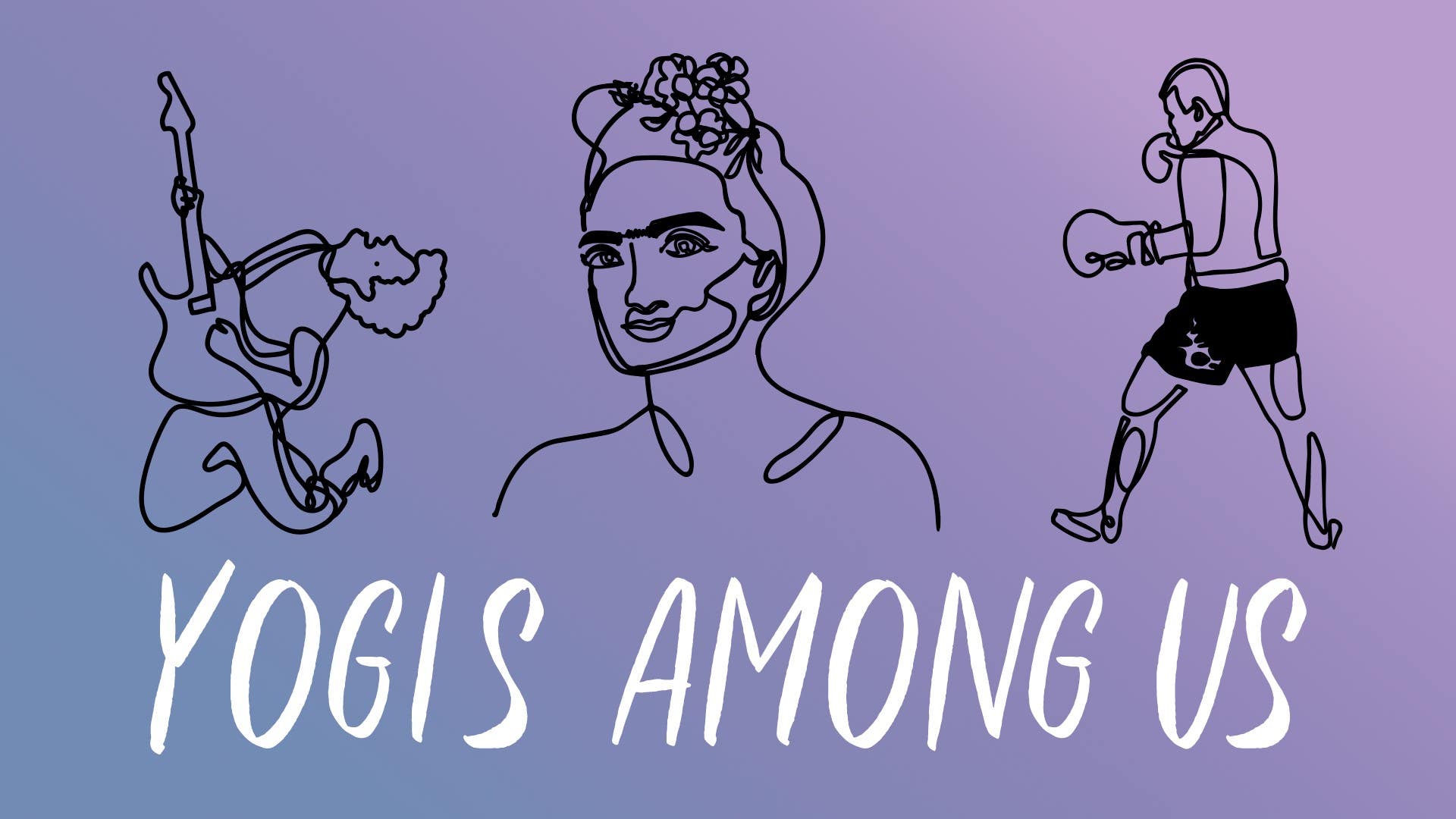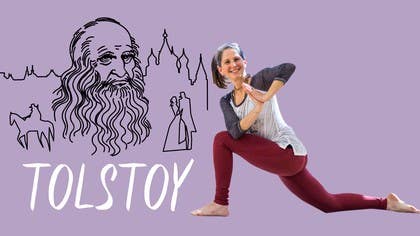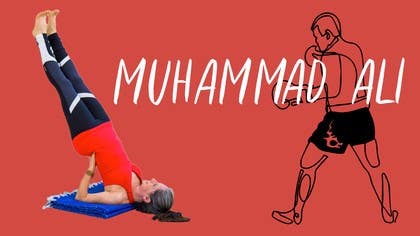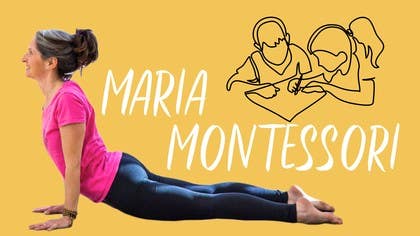Description
About This Video
Transcript
Read Full Transcript
Chapter 1
Talk
Leo Tolstoy started out living a pretty conventional life. He grew up in the first half of the 19th century. He was born to an aristocratic family. He fought for his country, Russia in the Crimean War, 1853 to 1856. And then in 1857, he was in Paris visiting and he witnessed a public execution in the street.
And the trauma of this event stayed with him and gave life to the seed that was already there inside of Tolstoy to advance the cause of peace in whatever way he possibly could. He had this visceral reaction against what he called state-sponsored violence. And he from then on would do and say and write anything he could to stand against that practice. It comes out in his literature very clearly. Almost every novel and every short story you will find a character that is an avatar for Tolstoy in terms of grappling with deep, dark and profound questions about who we are in the world as individual human beings and what our role is and how we can live in integrity and with love for all fellow man and woman kind.
In Anna Karenina, we have the character of Constantine Levin, who is constantly brooding and constantly searching for ways that he can make the lives of the recently freed serfs who are still working his land better. And in War and Peace, we have the awkward, bumbling, misfit character of Pierre. And Pierre, too, struggles mightily against the idea of war and how to find a peaceful existence. Pierre talks about love and he says that you can love another human being with human love. But to love an enemy is to love with divine love, which is clearly so much harder to attain.
This is the central tenet of the yogic teaching of Ahimsa. It's the first step of the first of the eight-limbed path of yoga. The word in Sanskrit means non-harming or non-violation. If you spin it around and assert it in the positive, it is love. Tolstoy said that the law of love is central to human nature and that there is no problem that can't be solved if we approach it from a place of open-hearted love.
In 1908, an Indian revolutionary named Tarak Nath Das wrote to Tolstoy. He had heard of him, he had read his writings, and he wrote to him asking for advice on how to advance the movement of Indian independence from British colonial rule. Tolstoy's response became the famous letter to a Hindu. And it was passed hand to hand to hand and landed in the hands of a young Mahatma Gandhi. And in this letter, Tolstoy reasserts his ideas that in standing up and fighting for a cause that you know is just and correct, if you fight with violence, you will only reinforce the thing that you're trying to eradicate.
And that only love will succeed in the end. But it's not a lie down and take it kind of love. It is a stand up with full love in your heart and say no, I will not pay taxes, I will not fight in your army, I will not participate in your unjust government, I will not allow you to rule my life, my community, my country. So civil disobedience is alive and well in the mind of Tolstoy and communicated to Tarak Nath Das, to Gandhi, and then spread throughout the world. They didn't make it up, but they took the ball and ran with it.
The ball was thrown to them from so many different directions, from Jesus Christ in the Sermon on the Mount, from William Lloyd Garrison, the Quaker abolitionist in the 1830s in his writings, from Henry David Thoreau a little bit later in his work with civil disobedience, advancing the cause of emancipation of the slaves. It was then thrown from Tolstoy and from Gandhi to Martin Luther King, to Nelson Mandela, to so many others throughout and into today. We find this ball too in the Bhagavad Gita. Krishna the teacher in the Gita, an incarnation of God, is instructing and giving counsel to our young warrior hero Arjuna, who is on the brink of a critical battle and he has a crisis of conscience. He forgets who he is and what his purpose in the world is supposed to be and he says to Krishna, I cannot fight this battle.
There are my cousins on the other side of enemy lines. And Krishna says, son, you've got it all wrong. One man believes he is the slayer and another man believes he is the slain and neither are correct. This is not a fight that will cause you to do harm to another. This is a battle for you to understand who you really are and who we all really are is love.
And if you approach your work with love in your heart and if you can see yourself in all others and all others in yourself, then things will turn out exactly the way they are intended to turn out. The big question around the teaching of the Bhagavad Gita is, wait a minute, this is not a nonviolent teaching. This is a violent teaching. Arjuna is being told by Krishna that he has to go fight and kill. So many scholars will agree that the war is a metaphor and it's a metaphor for the battle that goes on in the heart and the mind of every human being when we come upon a duty that we are afraid to pursue or that we think might be wrong.
Gandhi carried the Gita in his pocket. It was the book that he went to prison with. And he says that if every human being lived their lives according to the teachings of the Bhagavad Gita, war would be a thing of the past. This was a fervent wish that Tolstoy had. Gandhi referred to Tolstoy as the greatest apostle of nonviolence that our present age has ever seen.
So a practice dedicated to our loving friend Leo is going to be all about opening the heart. The start reclined with two blocks in what we call the heart bench.
Chapter 2
Practice
For the heart bench, make a sort of a capital letter T with your two blocks. So the top block is the cap of the T and the next block is the spine of the T. So you want the cap taller than the spine. The head lies back on the top part and your upper spine right between two shoulder blades goes right here.
So as you lie back, let the base of the spine of the T catch the base of your shoulder blades. Lie back. And carefully find the other block and put it right underneath the back of the skull. You don't want to tolerate any pain in the lower back here. So if there is any discomfort, you can turn each block on its lower setting.
Place the arms out to the sides and let the shoulder blades wrap around the block that's positioned in between them. As you inhale, you might feel the back rib cage expanding into the block that's right behind it. And as you exhale, you might feel the belly softening and drawing in. Notice how the shoulders feel, let them be broad all the way across the collarbones. Make sure your neck is comfortable.
You can play with dropping the chin a little closer to the throat or raising it a little further away from the throat until you feel a sense of ease. Take a couple more breaths here. And before you come out, just make sure that you're not going to pop your head up really fast, cause a dizzy spell or any other catastrophe. So just very slowly and intentionally press the hands, elbows into the floor. Begin to roll the spine up gradually, gradually, gradually until you are upright.
Let gravity resettle you. And then you can take the blocks away and lie back down with your knees bent, feet on the floor. Situate your heels so they're in a direct line in front of each sitting bone, few inches apart from each other. And press the shoulder blades into the floor firmly, so you feel the heart puff up a little bit. On an exhale, tip the pelvis back until you feel the lower back flatten into the floor.
And then at that point you may feel your tailbone hooking up toward the ceiling. Do that movement as the pelvis will rise now toward the ceiling and the chest lifts. And then roll everything right back down where it came from when the pelvis lands. Tip it forward slightly and then tip it back. Feel the tail hook up, lift the pelvis, bring the heart as high as you can comfortably and then roll it back down.
And here now you can add a lift of the arms. So the arms rise as the pelvis rises and as the spine rises. And then everything in concert can fall back down to the floor. Inhale, lift, exhale, drop. Inhale, lift, exhale, drop.
Two or three more times. You can add the feet here to emphasize the grounding of either end of the posture. So as you're coming down, you can work the feet as if you're pulling the floor toward you and as you're rising up, you can work the feet as if you're pushing the floor away from you. And then find your way back down, roll onto your side and come to table pose. In table pose, it's always nice to do just a few free flowing spinal maneuvers.
Awareness on the breath is always nice. And then coming back to a neutral table position, step one foot to the front, space between the two hands, fire up the legs for steadiness, pressing into the front foot at the sole and the top of the back foot and then raise the hands to the thigh. Lunge forward and test and make sure that the knee doesn't go in front of the ankle so you have a nice steady vertical shin. And then as you inhale, lift up, look toward the ceiling and let the heart rise up. Bring the palms together and down and then reach for the floor and switch feet.
Fire up the legs, ground down through the sole of the front foot and the top of the back foot, climb the hands up onto the thigh, make sure you're steady and anchored and inhale, reach up. Palms together, reach down and go back to the first side. So the foot comes forward, the legs get strong, the body is anchored, hands come up to the thigh, inhale, reach. This time we'll add a twist so palms come together in front of the heart and then turn to the side of your front leg, drop the opposite elbow onto the thigh, press your palms together and as the top palm in particular presses into the bottom one, you might feel the heart spinning up, opening. You can reinforce the grounding action here by turning the belly a little further down toward the floor, pumping up the work in the legs.
And then release hands down and step back. Other side. Steady in the legs, grounded in the feet, hands up on the thigh, inhale, reach up. Palms together and down in front of the heart and then turn to the side of your front leg, drop the opposite elbow onto the thigh, top palm pressing into bottom palm, heart spins up and bring awareness to the belly, turning down a bit, sending grounding energy through the legs. And then release, hands come down, step back.
Bring the first foot forward again and this time we'll come up into a warrior pose. So tuck the back toes, straighten the back leg, look at your back foot, turn it out slightly so you can get the heel firmly down on the mat. Strong legs, anchored feet, the heart is facing the short side of the mat, inhale, rise up. And we can consider this a compassionate warrior posture, a gesture of open-hearted engagement with whatever is in front of us, a non-violent showing up for life, ready to do whatever we need to do to avoid harming each other. And then reach down, spin the back foot so the toes point forward, release the knee to the mat and switch sides.
Tuck the back toes, straighten the back leg, press firmly through the back heel and then look at the back foot, turn it out a touch, land the heel on the mat, power up through the legs and down through the soles of the feet, the heart is facing the short side of your mat, inhale, reach up tall, open the heart. One more breath here and release, reach down, spin the back foot so the toes point forward, release the knee to the mat, step back to table pose, this time we'll do a high lunge twist, first foot steps to the front, tuck the back toes, straighten the back leg, press through the heel firmly. So we'll look to keep the high lunge position, so look at the toes on the back foot, they continue to look forward to the short side of the mat, we're powering up through the back leg and grounding through the front foot, reach up tall, inhale, palms together, exhale palms together in front of the heart, spin to the side of the mat that has your front leg on it and then the heart turns, palm to palm pressing down, heart spinning up, belly spinning down, legs strong. And then release hands to the floor, release the back knee down, switch sides, straighten the back leg, press through the heel, we'll keep the back heel lifted and the back toes pointing to the front of the mat, strong legs grounded through the front foot pressing firmly through the back heel, inhale, reach up, palms together and down in front of the heart and spinning to the side of the front leg, drop the elbow down onto the opposite thigh, palm to palm pressure, heart spins up, belly spins down, legs are strong, heart is open. And then release hands to the floor, the back knee comes down, step back to table pose, and then release the hips to the heels for child's pose, let the elbows come to the mat as far forward as they're comfortable, drop your forehead and raise your forearms with your palms behind your head, dig the elbows into the mat and make an action as if to slide them towards your knees but they won't move because you've dug them in.
One more breath and release, come back up onto your knees and all the way up standing on the knees, tuck your toes, hands to the hips, take the pelvis, tip it back just ever so slightly so you feel the tail and sitting bones descend and maybe scoop under a little bit and then lift your heart and lean back ever so gently opening the heart, exposing it upward toward the sky. You can extend one arm up and if it feels right for your lower back, reach down for the opposite heel, and switch sides, come back to neutral, hands on the hips, tip the pelvis ever so slightly back, feel the tail and the sitting bones scoop under, reach up with one arm, reach back and down for the other heel. The gaze is up beyond where the fingertips are reaching, heart is wide open and release, hands to the hips, come up. One more time, you can have both hands on the hips the whole time, you can reach both hands down for the heels. Do what's correct for your body always and release.
Without taking a sharp forward fold all of a sudden, just point the toes back and look to keep the torso pretty fairly upright as you sit back down on your heels and take a gentle little twist to one side and a gentle little twist to the other side and release, swing your legs out in front of you, come to lie down with your knees bent, feet on the floor. Open up the knees wide with the soles of the feet together, if this feels like a strain on the hips or on the groins you can use your two blocks to support the outer legs. And take your arms overhead, you can hold your wrists or your elbows like you're forming a halo over your head. With breath awareness here you can inhale as if the breath is streaming down through the crown of your head into the heart and exhale as if it's streaming back out through the arms circling overhead. And then with an alternating breath you can imagine streaming through the crown all the way down into the hips and pelvis and the exhale as if it's moving energy out through the legs and around into the feet.
Down into the heart, exhale out through the arms, inhale all the way down into the belly and the hips and out through the legs, three or four more rounds of breath. And then gently release the arms, bring them back down. You can use your hands to draw the knees together. Roll to your side, find your way up to sit, the palms together, take a quiet moment to find love in your own heart and to offer it out to those close to you, those adjacent to you, those far from you and those you may never meet in your life. May all beings be happy, may all beings be free from suffering, may all beings experience love in their heart.
Yogis Among Us
Comments
You need to be a subscriber to post a comment.
Please Log In or Create an Account to start your free trial.










